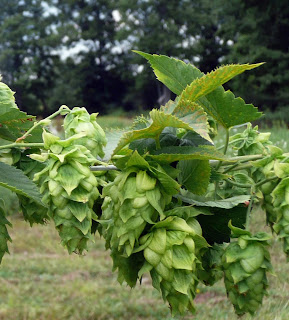I think there are lots of people that are like myself that want to start their own plants from a cutting. There is something intriguing about taking a dormant stick and watching life spring from under the seemingly dead bark. On the same hand, I have found such disappointment from watching a potentially alive stick do nothing more than rot away gradually before my eyes. Slowly, I am learning how to perfect the rooting process for better success rates.
Although the hardy kiwi is becoming more popular in nurseries, I think the vine is still a newcomer to most gardens, at least in the Mid Atlantic states around me.
The vines take several years to fruit - mine took almost ten years before we actually saw fruit, but a couple of those years, we saw early blossoms only to have a late frost that killed off any coming fruit, so we might have had fruit earlier.
One of the coolest things about rooting a cutting is that the plant takes on the age of the mother plant, so even though you might start rooting some cuttings, you won't have to wait seven to ten years to get fruit, rather two or three years or just until the plant is established enough to bear fruit.
Why would you want to grow hardy kiwis?
- they are delicious right off the vine - no peeling required
- the plants are pest proof
- the vine is a beautiful landscape plant
- the hardy kiwi vine grows fast!
- the hardy kiwi is still a unique plant
- the kiwi berries are very nutritious and rarely found in grocery stores
- the plant is very hardy and takes abuse
- Prepare a 50:50 mix of vermiculite and sand and dampen with water
- Fill plant pots or a deep tray with at least 6 inches of the prepared rooting mixture and press to flatten (I like translucent containers so I can see the root growth)
- Use the end of a pencil to poke holes about an inch shorter than the cutting
- Dip the freshly cut end of the cutting in rooting hormone
- Place the cutting in the hole
- Press the soil mixture firmly around each of the cuttings
- Cover the container to hold in moisture
- Place in a shaded area that stays warm (68-75 degrees F)
- Check the cuttings every week and mist if the soil mixture seems dry to the touch
- Wait and wait and wait some more.
Cuttings take time to root and hardy kiwis take at least two months if not longer. However, once you notice that the roots are started, the wait is forgotten and the excitement of a new plant takes over.
You can plant the cutting in a prepared garden bed or a plant pot. Think of growing hardy kiwis as you would a grape vine, but a grape vine on steriods.
You will need -
- a spot with full sun (8+ hours a day)
- soil with good organic matter and freely draining
- a strong six-eight foot trellis that will hold the vines off the ground.
If you are interested in starting your own cuttings and don't have a local source, you can check out my Etsy page here: Kiwi Berry Cuttings
References:
http://citeseerx.ist.psu.edu/viewdoc/download?doi=10.1.1.1039.2464&rep=rep1&type=pdf,
https://ssl.acesag.auburn.edu/department/peaches/kiwiprop.html















